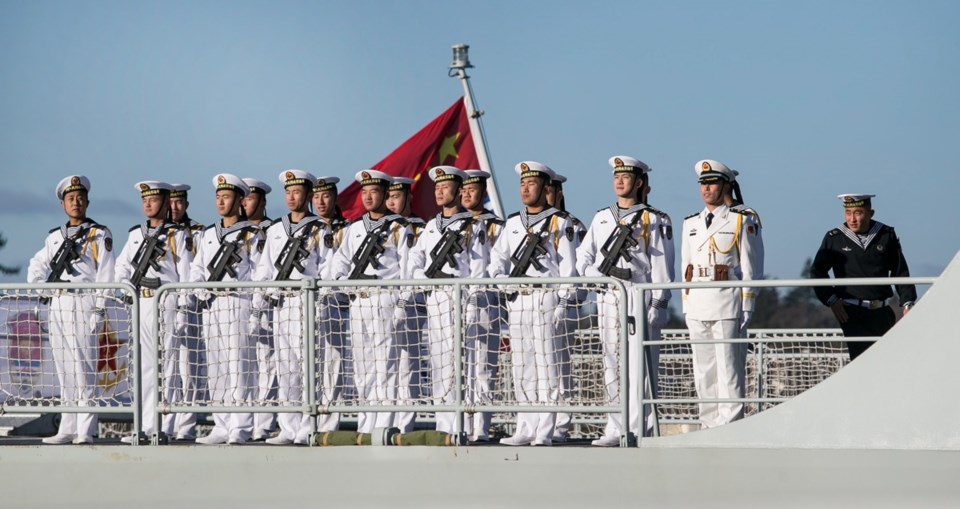An emboldened China and military aggression in the South China Sea — including an incident Friday in which the Chinese navy seized a U.S. underwater drone — have led to questions about the motives of China’s five-day visit to Canada’s West Coast.
Three Chinese People’s Liberation Army (Navy) vessels are docked at Victoria’s Ogden Point until Monday.
In announcing the visit, the Royal Canadian Navy said foreign navy vessels routinely visit Canada to “strengthen co-operation, goodwill and trust.”
The last time Chinese ships visited Victoria was in 2006.
“We don’t have any defence arrangements or ties with the Chinese,” said Douglas McClean, a retired commodore who helmed HMCS Protecteur for three years. “We have friendly but cautious relationships, I would say. I’m quite certain the Chinese navy isn’t here because the [Canadian] navy invited them.”
McClean said while Canada has been trying to establish closer diplomatic ties to improve trade relations with China, the two nations have “more different points of view than similar points of view when it comes to defence.”
“The South China Sea, their continual back and forth with Japan, is unsettling to say the least,” he said.
Dozens of people walked around the supply ship Taihu during public tours on Friday and more are expected to visit the ship during tours on Sunday. Visitors were asked to check large bags and passed through a metal detector but were allowed to bring cellphones and cameras on board. An English-speaking interpreter guided people around the ship.
The supply ship and two guided missile frigates made port visits to Auckland, New Zealand in October and San Diego this month.
“China made a request to the Government of Canada to visit Victoria after these port visits to Auckland and San Diego, and they were welcomed,” said CFB Esquimalt public affairs officer Lt.(N) Greg Menzies.
When asked why the ships are docked at Ogden Point, a commercial port, instead of CFB Esquimalt, where visiting allied navies are typically hosted, Menzies said: “Berthing arrangements at Ogden Point Terminal near downtown Victoria are best suited to the needs of the visiting Chinese ships. The ships have an active schedule during their visit that includes two days of public ship tours and various receptions in and around Victoria.”
Menzies said Ogden Point offers better access for public tours. “As the warships are making a goodwill visit to Canada, the Ogden Point facilities ultimately are better suited to accommodate a visit of this nature,” he said.
McClean said there is a host of sensitive communications and intelligence information at CFB Esquimalt so for security reasons, “any non-ally of ours would tie up downtown and not dockyard.”
He said when HMCS Protecteur visited China 20 years ago, the ship landed at civilian docks in Shanghai.
Bonnie S. Glaser, senior adviser for Asia and the director of the China Power Project at the Centre for Strategic and International Studies, said China has been making routine port visits to many countries, including Canada and the U.S.
“I think there’s been a belief in the U.S. military that there is a value to interacting with the Chinese military, that it helps to make the Chinese more professional and to understand what international norms are regarding operations at sea,” Glaser said.
An example of that, Glaser said, is that China was invited to participate in RIMPAC in 2014 and 2016, the world’s largest international maritime exercise involving 26 nations with interests — albeit sometimes competing ones — in the Pacific Rim.
Members of the U.S. Congress and U.S. defence experts called for the invitation to be rescinded as a result of China’s aggressive territorial claims and island-building program in the South China Sea.
On Friday, a Chinese warship seized a U.S. navy underwater drone collecting unclassified data in the South China Sea. The incident prompted a rebuke from the United States and a request to have the drone returned.
The incident is likely to strain already tense relations between the U.S. and China. Two weeks ago, China lodged a complaint over president-elect Donald Trump’s phone call with Taiwan’s leader Tsai Ing-wen, a breach of diplomatic protocol and a break from the One China policy.
— With The Associated Press
> U.S. demands drone’s return, A9



